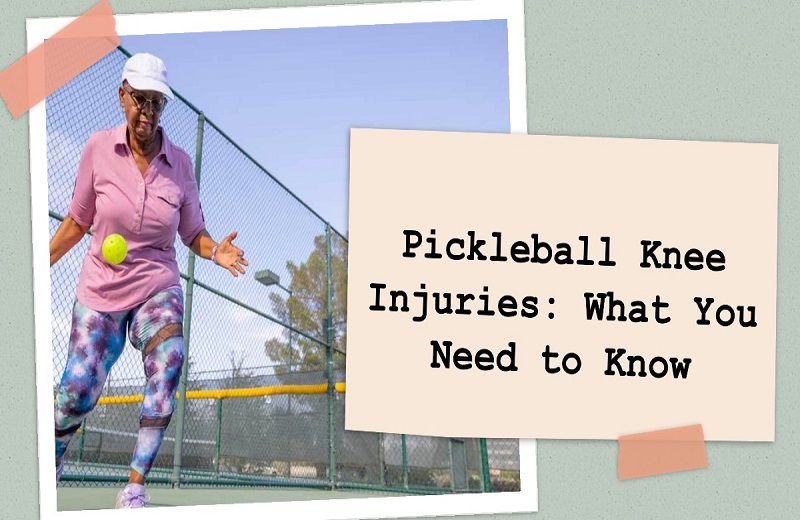Pickleball Knee Injuries Cause
I’ve experienced firsthand the exhilaration of the game, but also the physical toll it can take on your body, particularly the knees. The unique movements and demands of pickleball can lead to various pickleball knee injuries. Here are some of the main causes of this common pickleball injuries:
Overuse and Sudden Movements
Pickleball involves a lot of quick, sudden movements, including rapid changes in direction. This can put a lot of strain on the knees, leading to overuse injuries.
For instance, repeated jumping and landing can cause patellar tendinitis, an inflammation of the tendon connecting the kneecap to the shinbone. This is often felt as pain in the front of the knee.
Pickleball’s sudden movements and abrupt changes in direction can specifically put a strain on the Anterior Cruciate Ligament (ACL)
Pre-existing Conditions
If you have pre-existing conditions such as arthritis or previous knee injuries, playing pickleball can exacerbate these conditions, leading to increased knee pain. It’s crucial to manage these conditions and modify your play to prevent further damage.
Improper Technique
Improper technique can also contribute to knee pain. For example, if your knee wobbles during play, it can cause the kneecap to hit the sides of the knee joint, leading to patellofemoral pain syndrome. This is often felt as pain around or behind the kneecap.
Inadequate Warm-up and Cool-down
Not warming up properly before playing or cooling down afterward can lead to knee problems. A good warm-up prepares your muscles for the activity ahead, while a cool-down helps to gradually lower your heart rate and relax your muscles, reducing the risk of injury.
Inappropriate Footwear
Finally, wearing inappropriate footwear can lead to knee pain. Shoes that don’t provide enough support or cushioning can increase the impact on your knees. Also, shoes that don’t provide enough grip can cause you to slip or fall, potentially leading to knee injuries.
Symptoms Of Different Knee Injuries Types in Pickleball
Patellar Tendinitis
Patellar tendinitis, often referred to as “jumper’s knee,” is a common injury in sports that involve a lot of jumping or rapid changes in direction.
- In pickleball, this condition can develop due to the repetitive stress placed on the knee joint during the fast-paced movements of the game.
- Symptoms of patellar tendonitis include pain and tenderness around the patellar tendon (just below the kneecap), especially during and after activity.
Patellofemoral Pain Syndrome
Patellofemoral pain syndrome is characterized by pain in the front of the knee and around the kneecap.
- This condition is related to pickleball due to the high impact forces exerted on the knee joint during the game, especially during quick stops and starts.
- Symptoms include a dull, aching pain in the front of the knee, and discomfort when walking up or down stairs, kneeling, or squatting.
Joint Compression Issues
Joint compression issues occur when there is excessive pressure on the knee joint, leading to pain and discomfort.
- In pickleball, these issues can arise from the constant running and jumping, which puts a lot of stress on the knees.
- Symptoms of joint compression issues include pain during activity, swelling, and a feeling of tightness or pressure in the knee.
Muscle Strains and Sprains
Muscle strains and sprains in the knee can occur when the muscles or ligaments around the knee are stretched beyond their limits. In pickleball, this can happen during sudden movements or twists, which are common in the game.
- Symptoms of muscle strains and sprains include pain, swelling, and difficulty moving the knee.
Ligament Tears, Meniscus Injuries, and Osteoarthritis
Finally, more severe knee injuries that can occur in pickleball include sprains or meniscus and ligamentous injuries, and flares of knee arthritis.
- These conditions can develop over time due to the repetitive stress and high-impact forces associated with the sport.
- Symptoms vary depending on the specific injury but can include severe pain, swelling, instability, and decreased range of motion in the knee.
To learn more about the causes and symptoms of knee pain, check out this comprehensive guide on Understanding Knee Pain.
Prevention of Pickleball Knees Injury
Importance of Proper Training and Exercise To Reduce Risk
Regular exercise that includes strength training, flexibility exercises, and balance drills can help prepare your body for the demands of the game and reduce the risk of injury.
- Incorporate exercises that strengthen the quadriceps muscle, hamstrings, and calf muscles.
- Flexibility exercises can help maintain a good range of motion in your knees.
- Balance drills can improve your stability and reduce the risk of falls.
Is Pickleball it self a good Exercise? Check out this Page
The Role of Equipment and Technique in Preventing Injuries
Using the right equipment and maintaining proper technique is also vital in preventing pickleball injuries.
- Wear shoes specifically designed for pickleball to provide the right support and cushioning.
- Use a lightweight paddle to reduce strain on your wrists and arms.
- Maintain proper form when playing to avoid unnecessary strain on your knees.
Tips for Safe Play
Safe play is crucial in preventing injuries.
- Warm up before every game to prepare your muscles for the activity.
- Cool down after playing to help your muscles recover.
- Listen to your body and stop playing if you feel pain.
Importance of Regular Breaks During Play
Taking regular breaks during play can help prevent overuse injuries.
- Rest periods allow your body to recover and can help prevent fatigue-related mistakes that could lead to injury.
The Role of Hydration and Nutrition
Staying hydrated and maintaining a balanced diet can also play a role in injury prevention.
- Drink plenty of water before, during, and after play.
- Eat a balanced diet rich in protein, fruits, vegetables, and whole grains to provide your body with the nutrients it needs to recover and stay strong.
Benefits of Cross-Training
Cross-training can help balance your muscle groups, increase your overall fitness, and reduce the risk of injury.
- Consider incorporating activities like swimming, cycling, or yoga into your fitness routine.
The Role of Protective Gear Like Knee Braces or Supports
Using protective gear like knee braces or supports can provide additional support and stability to your knees.
- Consult with a healthcare professional to determine if knee supports could be beneficial for you.
Treatment for Pickleball Knee Injuries
Immediate Treatments
When you first notice knee pain, it’s crucial to take immediate action. I can’t stress enough the importance of rest and ice. Just like when I had my first knee injury, taking a break from the game and applying ice to the affected area can significantly reduce pain and inflammation.
Over-the-counter pain relievers can also be beneficial. Ice and over-the-counter pain medications can help control the pain and allow your body to heal. However, these should be used responsibly and only as a temporary solution.
Physical Therapy
In my experience, physical therapy plays a vital role in recovery from knee injuries. Therapists can guide you through specific exercises designed to strengthen the muscles around your knee and improve flexibility. Exercises like leg raises and hamstring stretches are particularly helpful. Learn more about Physical Therapy for Knee Pain.
Long-Term Solutions
For long-term solutions, strength training and conditioning are key. You can ask for training aid. Regularly working on your lower body strength can help prevent future injuries. Also, maintaining a healthy weight can reduce the strain on your knees.
Lifestyle changes are also crucial. This could involve adjusting your pickleball technique or investing in better footwear. Regular flexibility and balance exercises can also help keep your knees in good shape.
Alternative Treatments
In some cases, alternative treatments like massage, acupuncture, or chiropractic care can be beneficial. I’ve known players who have found relief through these methods. However, it’s important to consult with a healthcare professional before starting any new treatment regimen.
When to Seek Medical Attention
It’s important to know when to seek medical attention. If your knee injury is severe, if it doesn’t improve with rest, or if your knee is unstable, it’s time to see a doctor. A professional diagnosis and treatment plan can help ensure you recover fully and can return to the game you love.
Case Study: Juliet’s Experience with Pickleball Knee Pain
I remember the first time Juliet (name changed for privacy) came to me, her face etched with the pain that had been plaguing her for weeks. Her knee pain had sidelined her, casting a shadow over the sport she loved.
Juliet’s Experience with Knee Pain
Juliet’s knee pain started as a mild discomfort, a whisper of a problem that she brushed off as just another part of the game. But as the weeks went by slowly, the whisper turned into a shout that she could no longer ignore.
She described the pain as a sharp, stabbing sensation at the front of her knee, especially when she was playing pickleball.
Addressing the Pain
Juliet decided to take action. She sought help from a physical therapist who specialized in sports injuries. The therapist diagnosed her with patellar tendinopathy, a common issue among pickleball players. Juliet was relieved to have a diagnosis but knew she had a long road ahead of her.
Juliet’s Treatment Plan
The treatment plan was multifaceted, addressing not only the pain but also the root cause of the issue. Juliet started with cold therapy, using an ice cube to calm the inflamed tendon. She then moved on to contrasting cold and heat therapy to increase circulation in the area.
She also used a massage device to bring more circulation and relaxation to the area. Juliet found this particularly helpful in relieving the tension in her quadricep muscles, which were pulling on the tendon and causing the pain.
Modifying Play to Prevent Future Injuries
Juliet knew she had to make changes to her pickleball game to prevent future injuries. She started focusing on her glute muscles, strengthening them to take the pressure off her knee.
She incorporated exercises like squats and leg raises into her routine, ensuring she was activating the right muscles and not overusing her knee.
Juliet’s Advice for Other Players
Juliet’s journey back to the pickleball court was not easy, but she learned valuable lessons along the way. Her advice to other players experiencing knee pain is to listen to their bodies and seek help sooner rather than later.
She also emphasizes the importance of strengthening exercises, particularly for the glute muscles, to prevent knee overuse.
Juliet’s story is a testament to the power of perseverance and the importance of proper treatment and prevention strategies. Her journey back to the pickleball court serves as a beacon of hope for others dealing with similar issues.
Can pickleball cause knee problems?
Should I wear a knee brace while playing pickleball?
How do you prevent knee injuries in pickleball?
What is the most common pickleball injury?
Conclusion
Knee pain in pickleball is a common issue that can be managed with the right approach. Wendy’s story illustrates the importance of early intervention, proper treatment, and preventive measures. Listen to your body, seek professional help when needed, and prioritize strengthening exercises to prevent overuse and future injuries.
Related Article:


